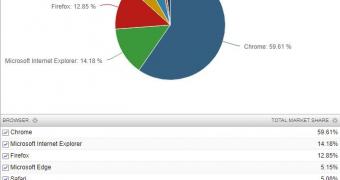Microsoft launched Edge browser with much fanfare in Windows 10, promising to make it at least as good as Google Chrome and Mozilla Firefox.
But despite all the efforts put into the browser market, Microsoft is actually losing the war against Google and Mozilla and, at first glance, the software giant isn’t very concerned about it.
Statistics that were published by NetMarketShare for the month of September 2017 reveal that Google Chrome was the leading browser on the desktop with no less than 59.61 percent, which means that nearly 6 out of 10 computers out there are using Google’s app.
Internet Explorer continues to be the second choice despite the massive drop with 14.18 percent, while Mozilla Firefox is third with 12.85 percent. Microsoft Edge is fourth with 5.15 percent.
This means that right now, Microsoft’s browsers have only 19.33 percent market share, so less than 2 in 10 users have decided to stick with Internet Explorer or Edge on Windows.
IE and Edge going down
And what’s worse is that both Internet Explorer and Microsoft Edge are declining, despite the latter being the company’s latest browser and rather aggressively pushed as the best alternative to Google Chrome. Last month, Microsoft Edge dropped from 5.66 percent to 5.15 percent, while Internet Explorer collapsed from 15.58 percent to 14.18 percent.
Internet Explorer is no longer getting any new feature updates, but only security patches, as the full focus in on Edge on the desktop.
Microsoft isn’t very keen on dealing with Edge’s biggest problems, and the company sticks with a feature release that’s tied to the launch of new Windows versions. In other words, Edge is getting new features only when Microsoft ships new Windows versions, as compared to the likes of Chrome and Firefox which are updated significantly more often.
The number of extensions for Microsoft Edge is also terribly small versus the one for Google Chrome, with less than 100 add-ons currently available.
In the meantime, Microsoft seems to be more interested in bringing Edge on non-Windows platforms rather than improving the browser on its own, and with such an approach, it’s hard to believe a bigger market share can be reached anytime soon.

 14 DAY TRIAL //
14 DAY TRIAL //